Featured Comment:
“It was delicious and so easy to make. It tastes just like the delicious homemade ochazuke I had at a restaurant in Japan. Thank you!”
– Tran
What is Ochazuke?
Ochazuke (お茶漬け) is a simple yet profoundly comforting dish made by pouring hot tea over rice with toppings. It’s a kind of dish that offers both nourishment and emotional restoration after a draining day when your mind won’t quiet down.
While traditionally made with Japanese green tea, you can use dashi or other broths based on what you have available. The savory umami of salmon infuses the liquid, creating a harmonious blend that’s both light and satisfying.
The beauty of ochazuke is how it takes simple ingredients and makes them into something special. The hot liquid brings new life to leftover rice, connecting you to centuries of wisdom. When you’re caught between a everyday responsibilities and wanting to try something new, this easy meal is the perfect mix of comfort and cultural flavors to fit your schedule.

Salmon Selection
The table below will help you choose the best option for your needs.
| Salmon Type | Benefits | Usage Tips |
|---|---|---|
| Fresh Salmon Fillet | • Less fishy smell with rich umami • Control your own salt level • Creates the cleanest flavor | • Choose firm flesh with silvery skin • Avoid packages with excess liquid |
| Salt Cured Salmon | • Already infused with umami from salt curing • Perfect for quick preparation | • Rinse briefly under water to adjust saltiness • Skip the salting step if you use this |
| Leftover Grilled Salmon | • Ultimate convenience • Zero waste solution • Fastest preparation | • Works with any leftover salmon • Mix with leftover rice for an ultra-quick version |
| Smoked Salmon | • No cooking required • Widely available • Unique smoky dimension • Creates a fusion-style ochazuke | • Cold-smoked varieties provide silky texture • Hot-smoked offers more traditional flakiness • Use sparingly due to high salt content • Dab excess oil if using oil-packed varieties |
| Canned Salmon | • Pantry-friendly emergency option • Budget-friendly • Quick to prepare | • Drain thoroughly and remove any bones • Add extra toppings to enhance flavor • Consider as a last resort rather than a first choice |
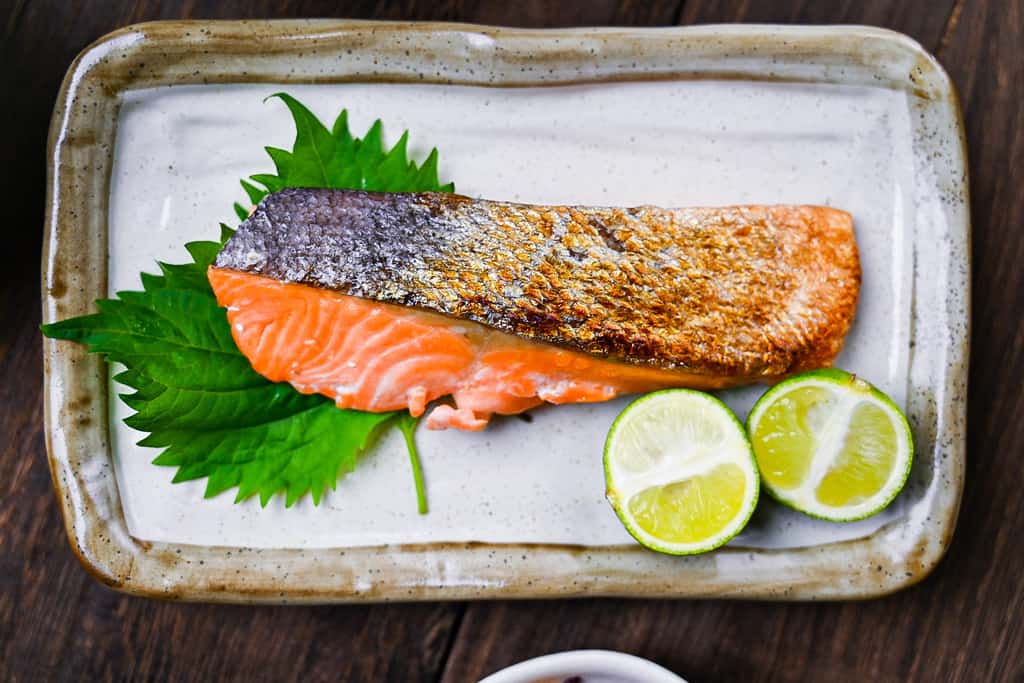
This recipe uses fresh salmon, but feel free to adapt it based on what’ you have on hand’s available in your area. Don’t forget that ochazuke is all about convenience and practicality. Use what works best for you!
Rice Selection
| Rice Type | Benefits | Texture Profile | Best For |
|---|---|---|---|
| Japanese Short-Grain Rice | • Perfect stickiness level • Authentic flavor • Maintains structure when tea is added | Fluffy when fresh; chewy with good bite when cold | The most authentic ochazuke experience |
| Calrose Rice | • Widely available in the US • Medium-grain substitute • Reasonable price point | Slightly less sticky than Japanese rice but works well | Everyday convenience when Japanese rice isn’t available |
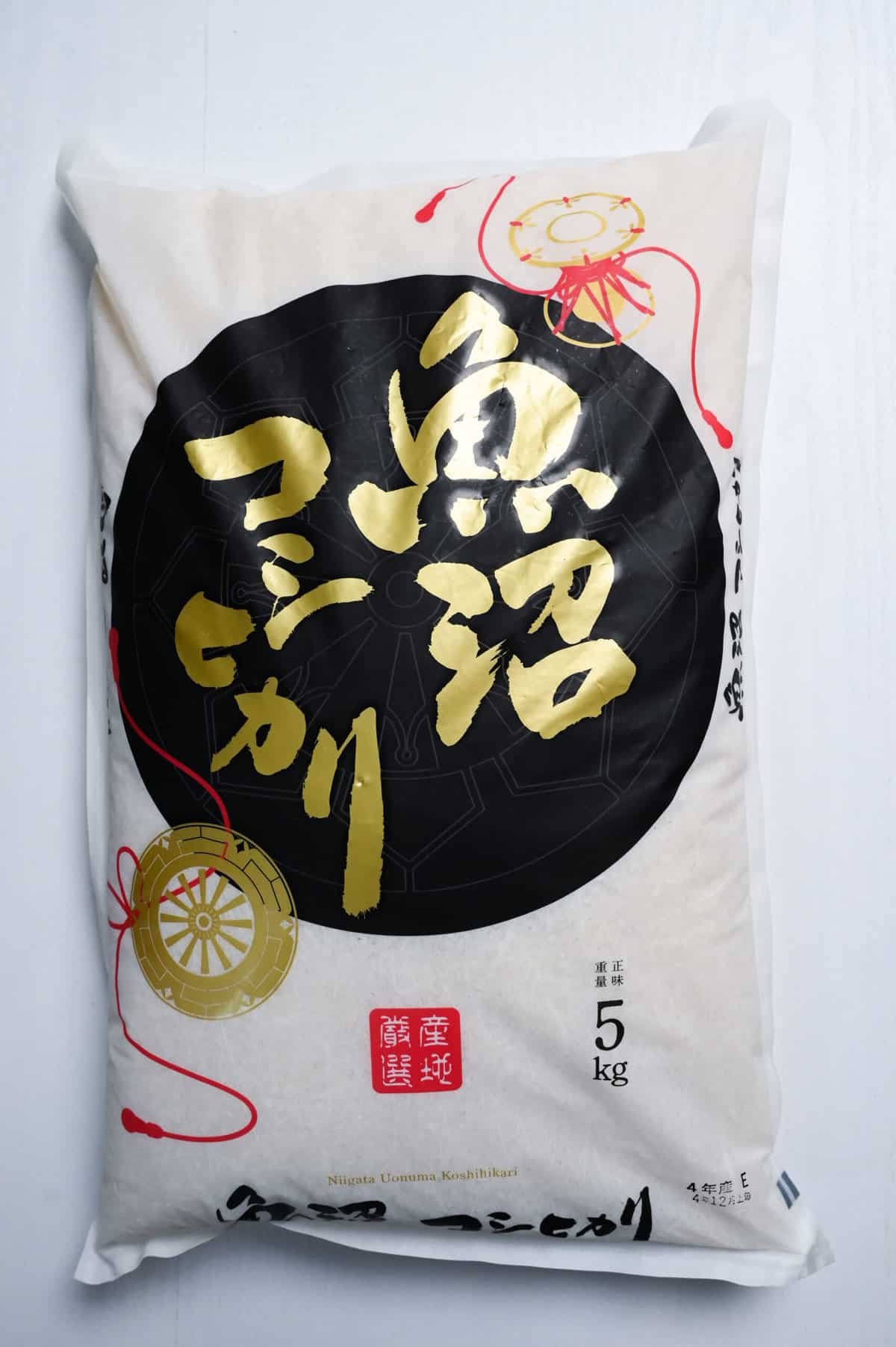
Avoid long-grain rice varieties (like Basmati or Jasmine) for this since they’re too dry and tend to separate.
- Freshly cooked rice: Fragrant and fluffy, creating a smoother texture when tea is added.
- Leftover cold rice: Firmer texture that gradually softens after the hot tea is poured.
Tea Selection
| Tea Type | Flavor Profile | Perfect For |
|---|---|---|
| Regular Japanese Green Tea | Light astringency, fresh vegetal notes, moderate umami | Traditional experience; balancing salmon’s richness |
| Hojicha (Roasted Green Tea) | Toasty, nutty flavor, low astringency, minimal caffeine | Evening meals; its roasted aroma enhances salmon’s flavor without competing |
| Genmaicha (Green Tea with Roasted Rice) | Toasty rice notes with green tea background | Morning ochazuke; stimulates appetite through its appetizing aroma |
| Dashi Broth (Not tea, but common) | Pure savory umami with no astringency or caffeine | Restaurant-style experience; pure savory comfort |
In my recipe, I take a creative approach that captures the best of both worlds by brewing a green tea bag directly in hot dashi broth. This hybrid method delivers both the umami depth of dashi and the refreshing qualities of green tea in one elegant solution.
Feel free to choose whichever method speaks most to what you’re craving.
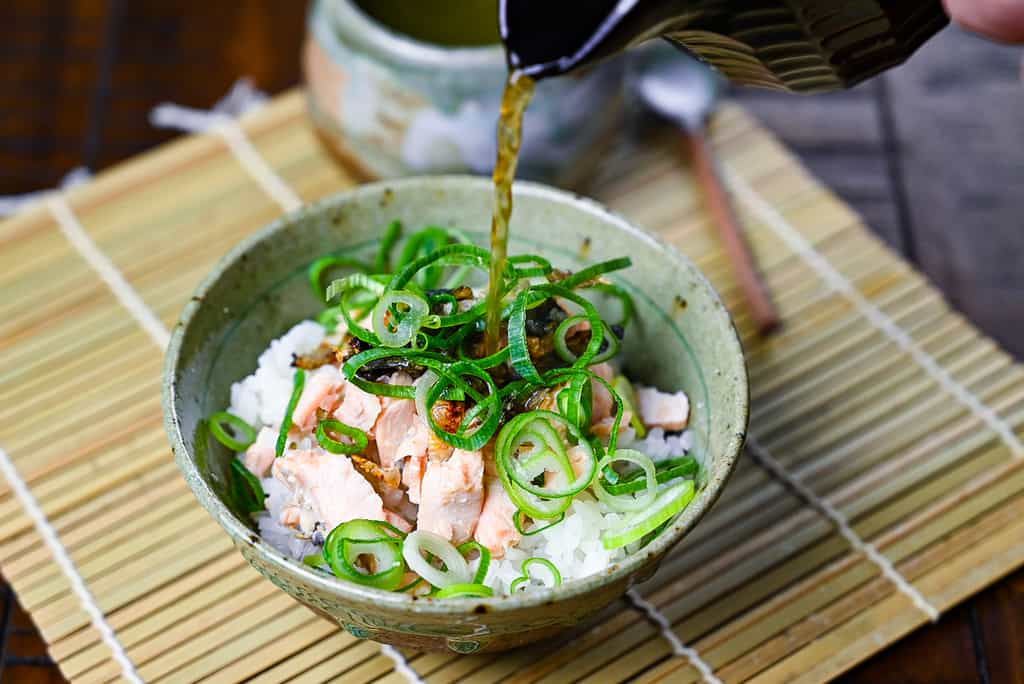
Visual Walkthrough & Tips
Here are my step-by-step instructions for how to make Salmon Ochazuke at home. For ingredient quantities and simplified instructions, scroll down for the Printable Recipe Card below.
If you prefer to watch the process in action, check out my YouTube video of this Ochazuke recipe for a complete visual walkthrough!
Dry the salmon fillets thoroughly with paper towels. Then, season both sides with a light layer of salt. Cover the fillets and let them rest for about 20 minutes. If it’s warm outside, let them rest for 10 minutes or pop the plate into the fridge.
You could make shiozake for dinner the night before and save the leftovers to use for ochazuke, or you could use my salmon flakes to skip the whole process of making salmon. Or as mentioned above, use one of the store-bought alternatives.
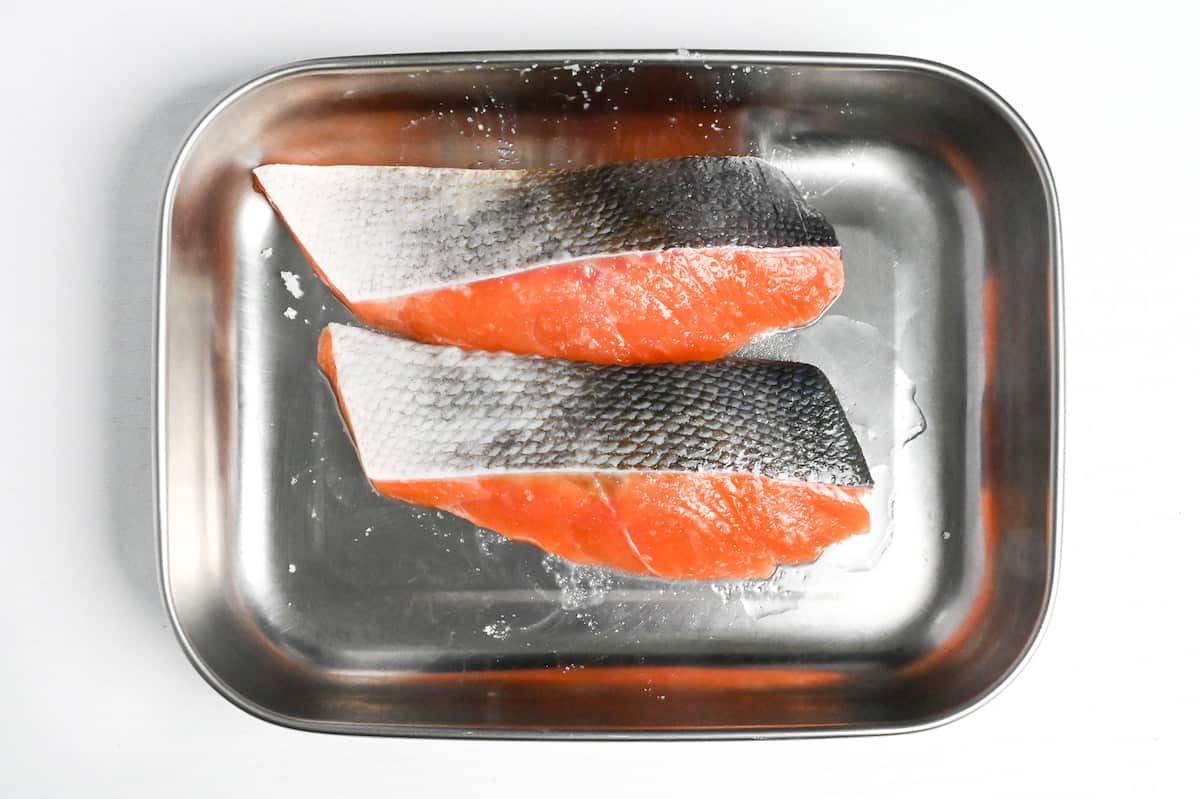
Five minutes before the timer is up, turn on your broiler and set the temperature to medium-high.
Salt pulls surface liquid (where most odors hide) out of the fish. Less surface moisture = better browning and crispier skin too!
When the fish has rested, dab it dry again and drizzle small amount of sake over the flesh to not only remove the odor further, but also makes the flesh more tender.
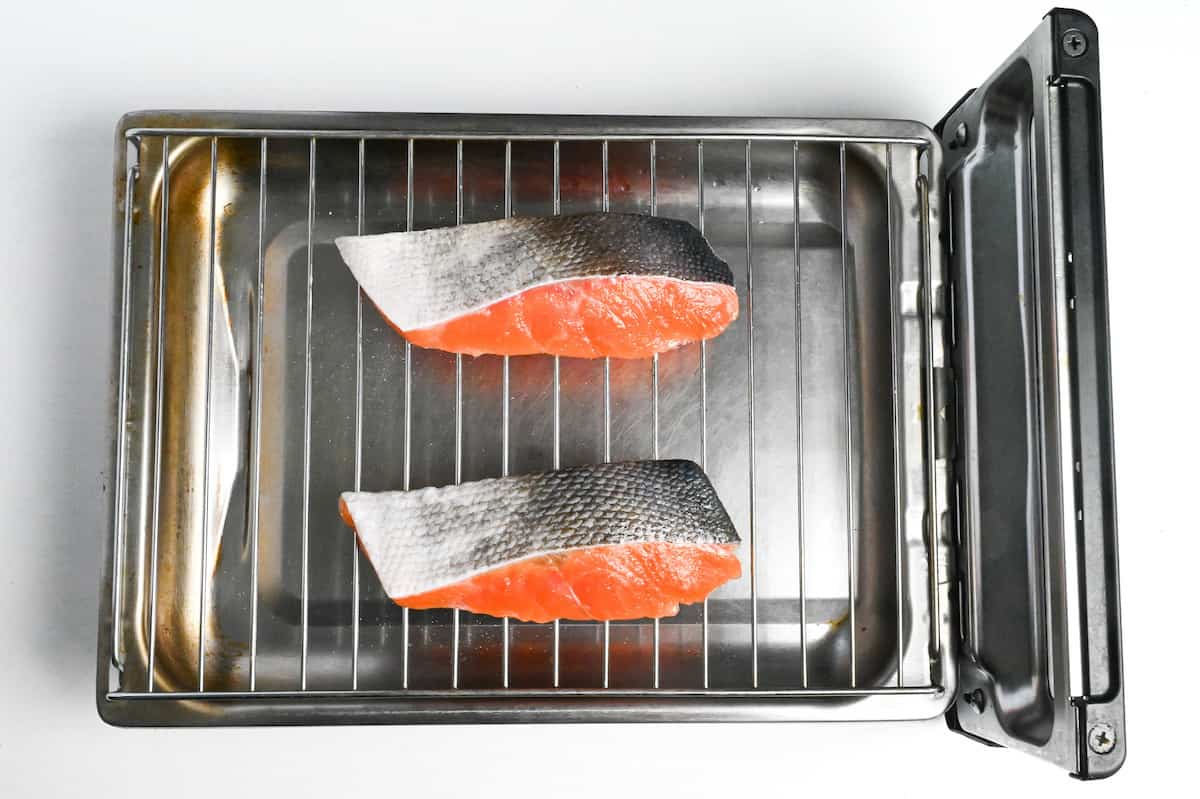
Grill with the skin-side facing the heat source until crispy, then flip and cook until done. You will know when the salmon is cooked through because the skin will appear opaque and pale pink.
On average, I cook it for 3-4 minutes on each side (possibly longer on the skin side and shorter on the flesh side). The timing varies depending on the thickness of your fillets.
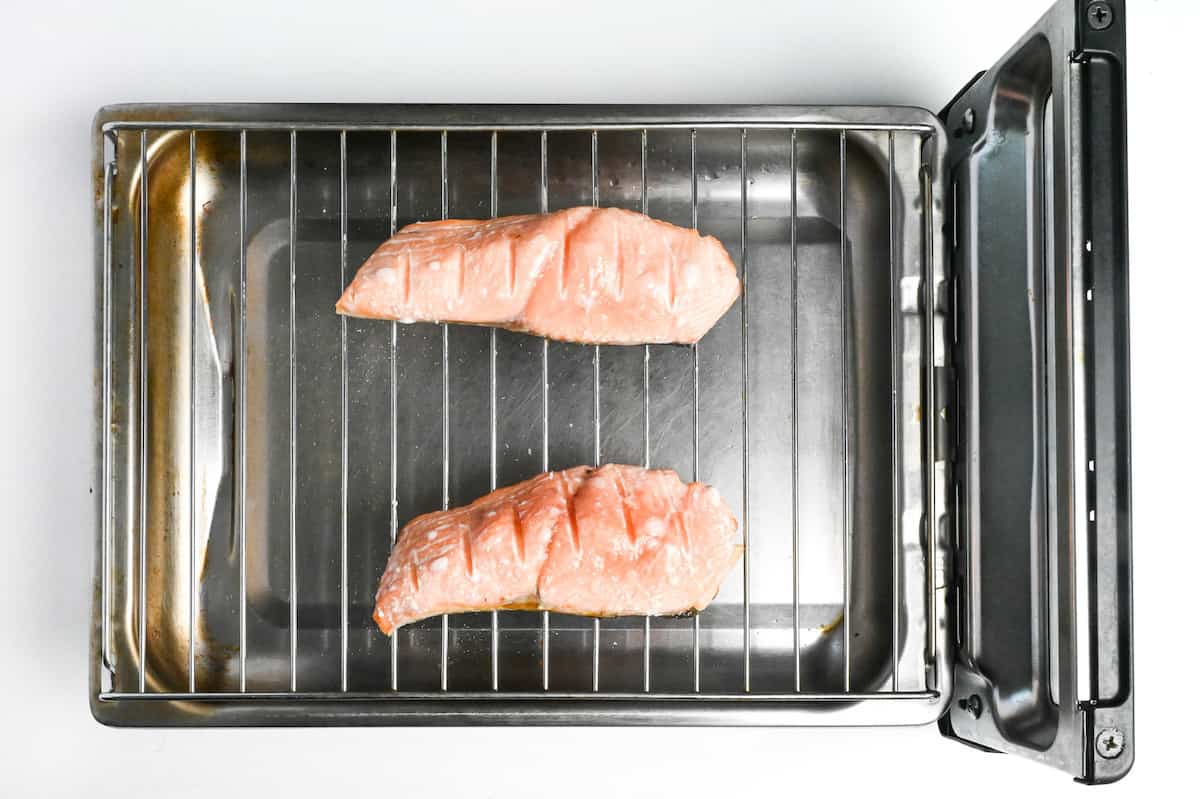
The moment the translucent dark pink turns pale and the albumen (that white protein) dots the surface, the salmon is done.
Remove skin from grilled salmon and slice it thinly.
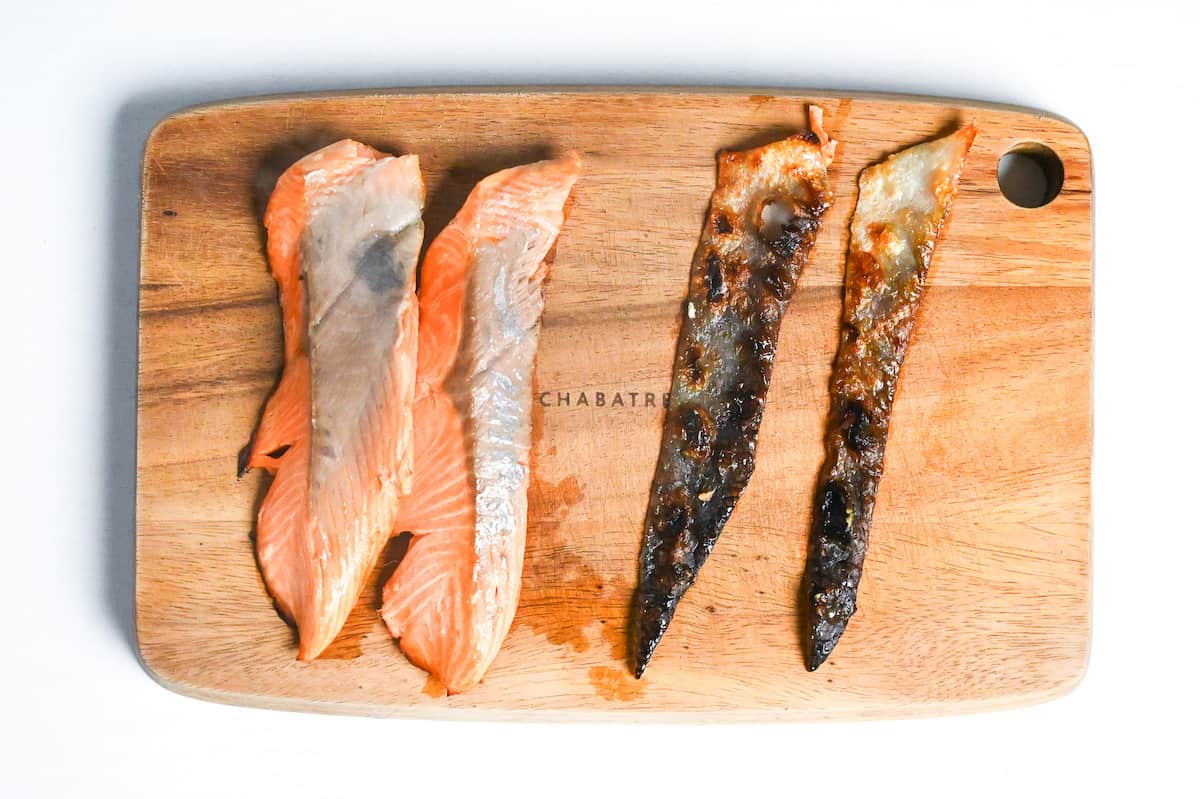
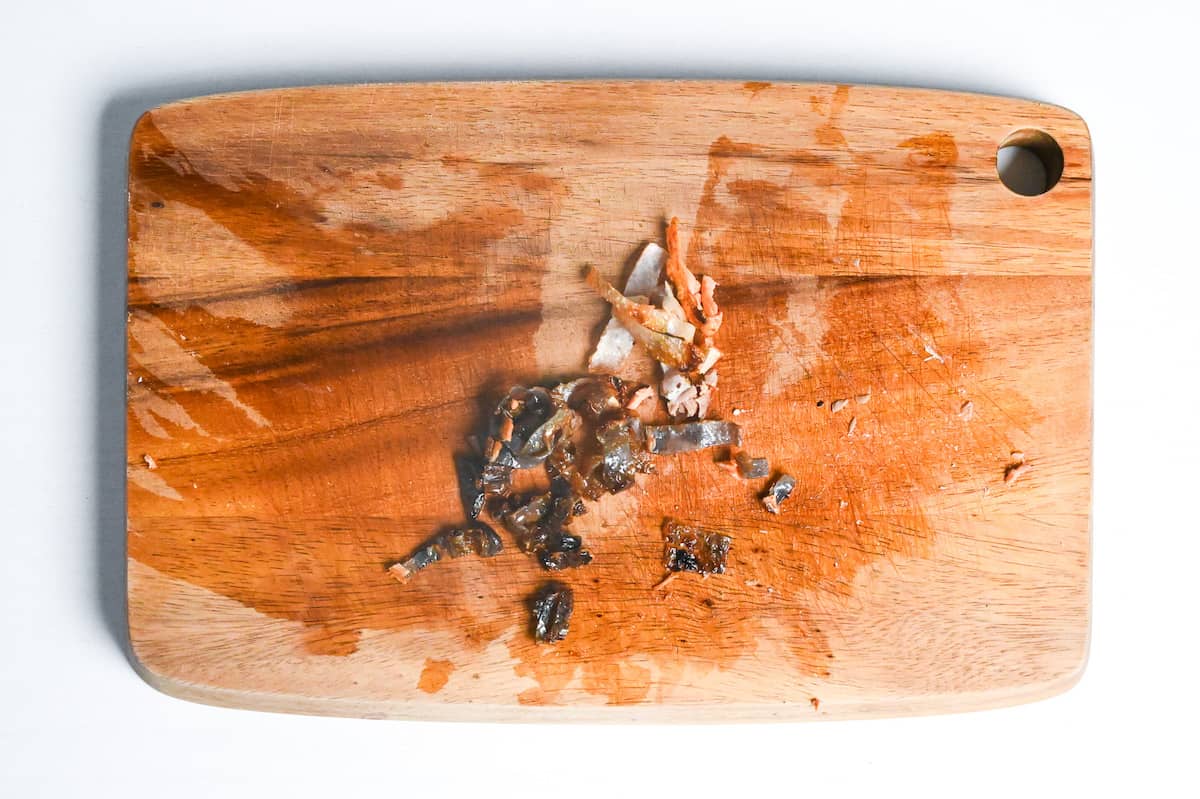
Once the fish is warm but not piping hot, gently break it into bite-sized flakes with chopsticks or a fork. Check carefully for bones, use chopsticks or tweezers to pick them out.
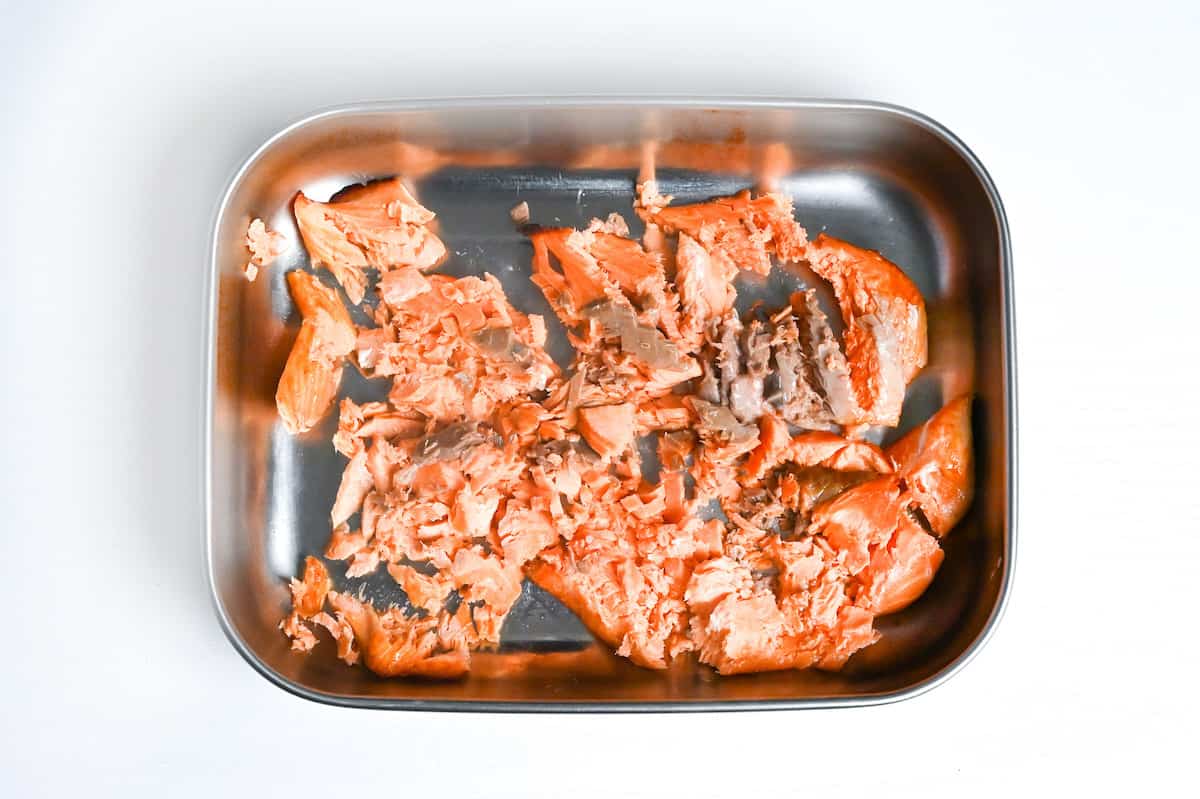
Heat dashi stock to 80 °C (175 – 180 °F) and steep green tea for 1-2 minutes. This lower-temperature brew coaxes out sweet theanine and fresh grassy notes while reining in bitterness.
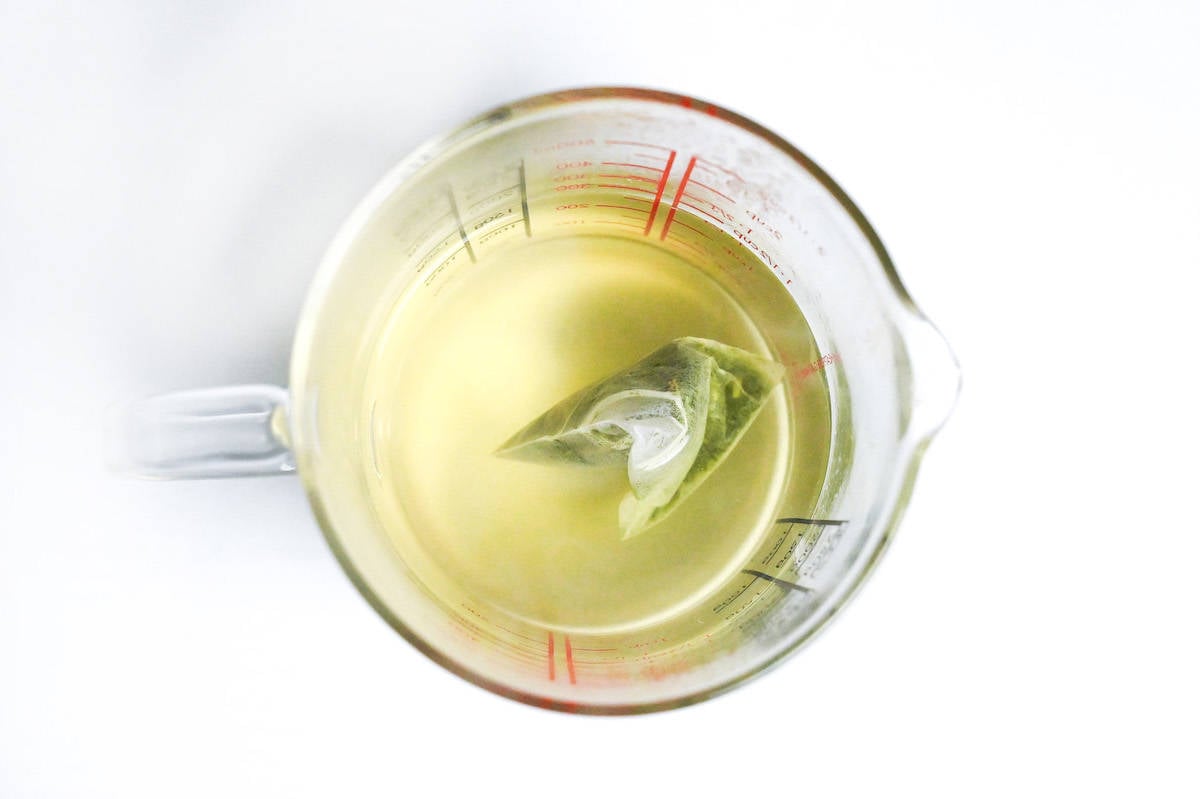
Remove the teabag, and stir in soy sauce for depth and saltiness.
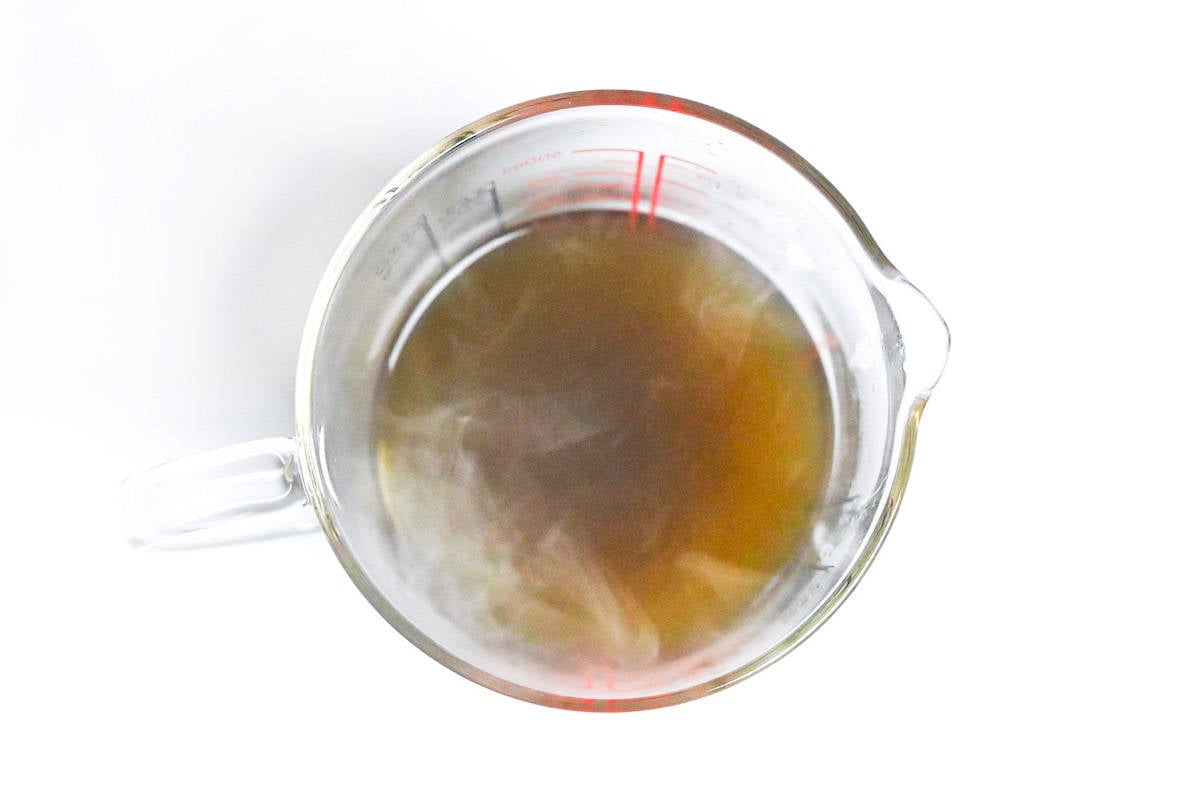
Divide cooked rice into serving bowls and sprinkle the top with ground sesame seeds. The average portion of rice is about 150g per bowl (after cooking).
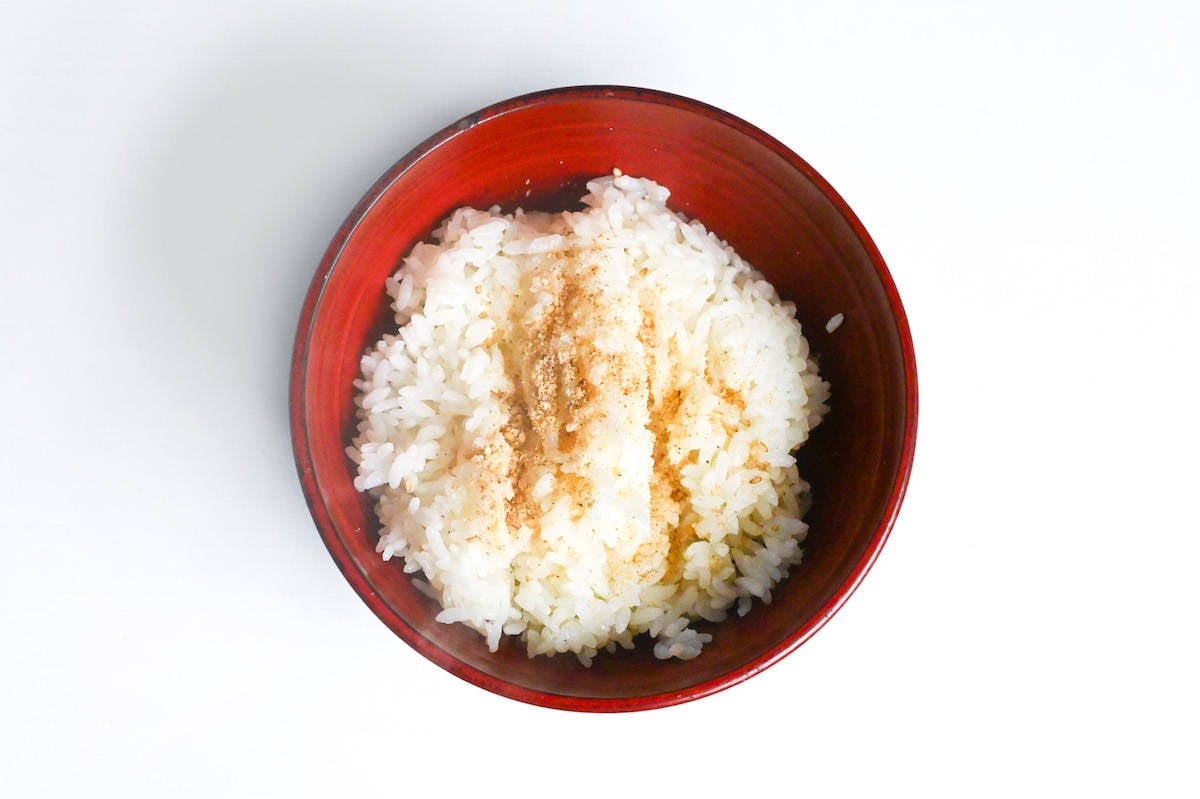
Top with salmon flakes, crispy skin, and chopped green onions, then pour the tea/dashi mixture over the top.
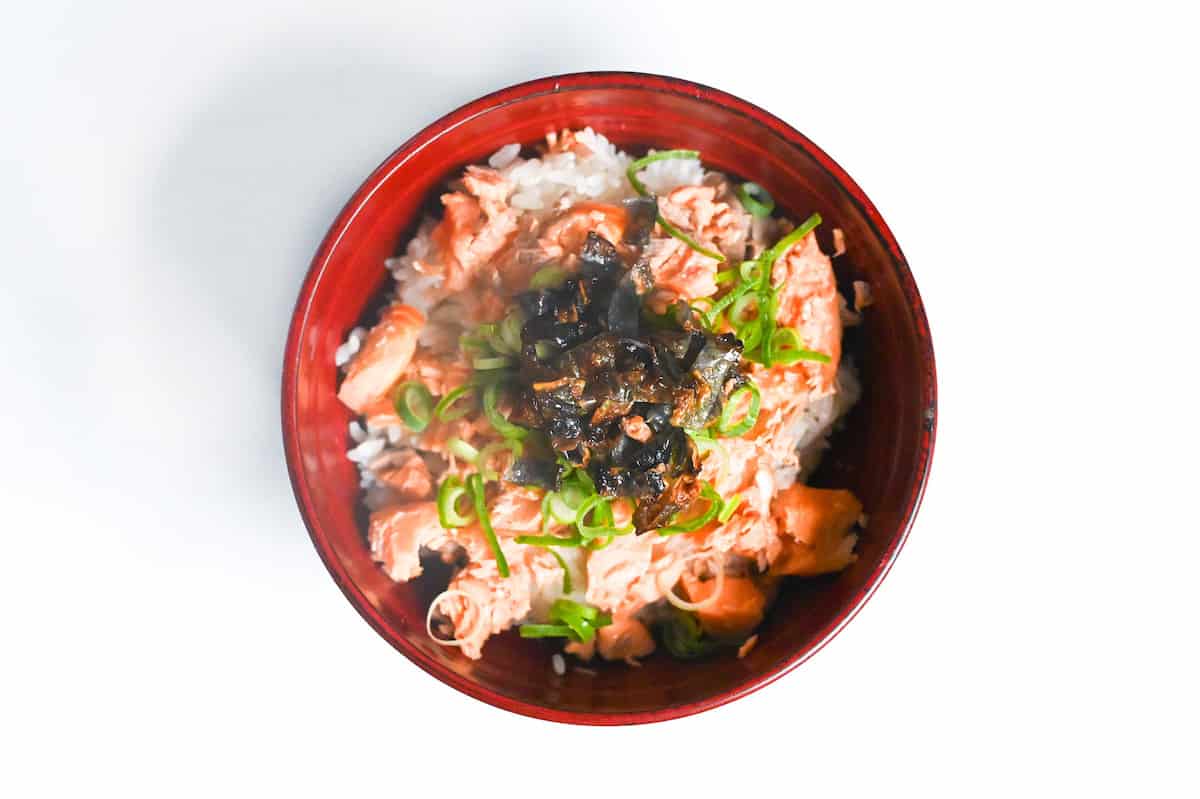
Garnish with shredded (kizami) nori and wasabi to taste.
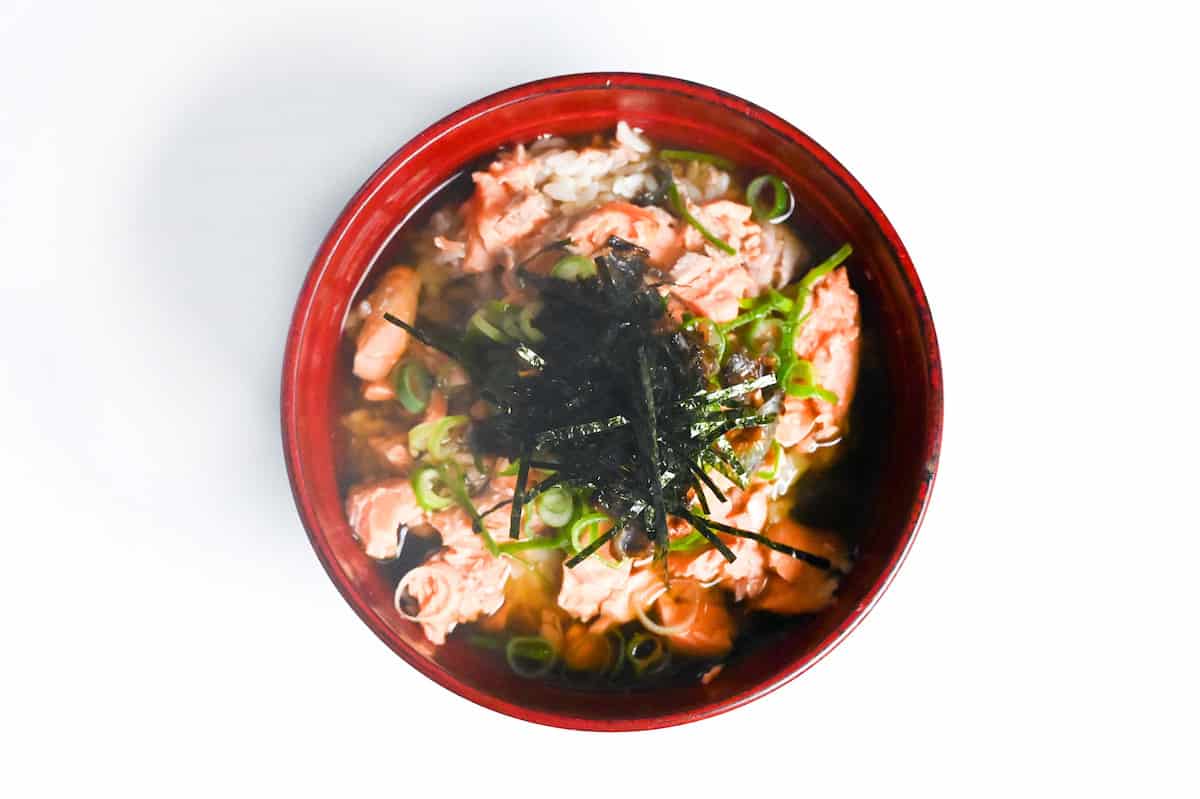
- Mitsuba leaves
- Shredded shiso leaves
- Arare (tiny rice crackers)
- Umeboshi (pitted, chopped)
- Yuzu zest
- Sudachi juice or wedges
- Shichimi togarashi
- Ikura (salmon roe)

Essential Tips & Tricks
- Pat salmon completely dry before and after salting.
- Broil skin-side first. Flip when the skin blisters and finish until the center hits 63 °C/145 °F.
- Flake the salmon only once it’s warm.
- Steep the tea bag in 80 °C (175 – 180 °F) dashi for 1-2 minutes, longer if you prefer a more intense tea flavor.
- Eat right away. Rice keeps soaking up liquid and turns mushy if left to sit.
With these simple tips in mind, you’re set for success every time you make Salmon Ochazuke.
Meal Prep & Storage
This salmon chazuke is only partially meal-prep friendly. Assembling bowls is quick and easy, but several components store well.
- Component Prep: Salmon Flakes: Grill, flake, cool, and portion into airtight containers. Refrigerate up to 3 days or freeze up to 2 weeks. Rice: Freeze freshly cooked rice in single-serve packs; reheat from frozen in the microwave for the best texture.
- Storage Guide: Don’t store assembled ochazuke. Instead, you can store the individual components separately and assemble right before serving.
Serving Suggestions
FAQ
Here are answers to frequently asked questions I have received across all platforms, including here, YouTube, Instagram, and Pinterest. If you have any questions, feel free to send them to me anytime! It will be a big help for everyone in this community!
Its roots trace back to the Heian era (794-1185) “yuzuke (湯漬け),” rice doused with hot water. The modern tea-based version became fast food for Edo-period (1603-1868) city folk who needed a quick meal between long work shifts.
It’s a classic shime (post-drinking closer). After a night out, the hot, salty broth rehydrates the body and settles the stomach, just like a lighter, five-minute alternative to ramen.
Absolutely. Try salt cod for a delicate taste, marinated snapper sashimi for elegance, or even shredded roast chicken for a lean option. Just bump up soy or dashi if the new protein is mild.
Keep crispy elements (nori, rice crackers, extra roast salmon skin) until serving, drizzle broth gently around the toppings, and add a bit of yuzu zest for an instant “restaurant” look and taste.
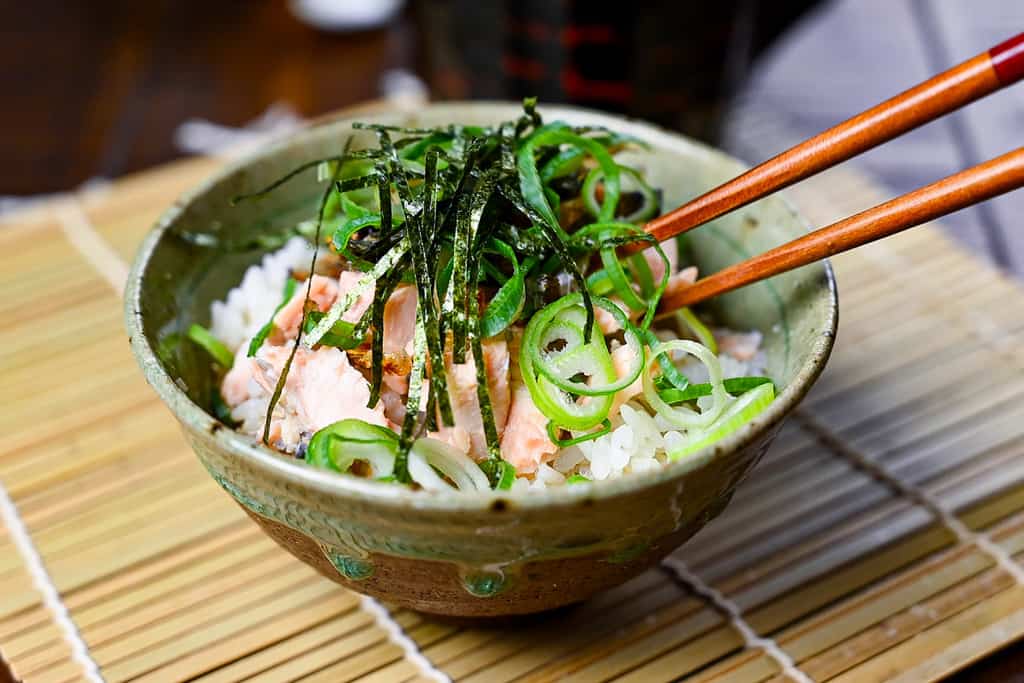
I hope you enjoy this Salmon Ochazuke recipe! If you try it out, I’d really appreciate it if you could spare a moment to let me know what you thought by giving a review and star rating in the comments below. It’s also helpful to share any adjustments you made to the recipe with our other readers. Thank you!
More Japanese Salmon Recipes
- Pan Fried Japanese Teriyaki Salmon
- Japanese Salmon Rice Balls (Sake Onigiri)
- Miso Glazed Salmon (Pan-fried)
- Ponzu Salmon (Pan Fried)
Hungry for more? Explore my salmon recipe collection to find your next favorite dishes!
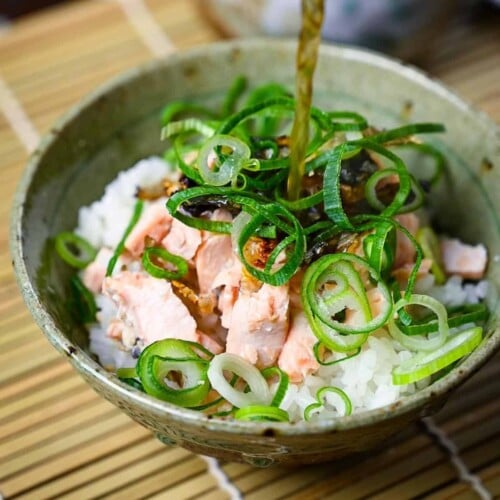
Salmon Ochazuke (Japanese Tea on Rice)
Ingredients
- 200 g salmon fillets skin-on
- ½ tsp salt
- 1 tsp sake optional
- 300 ml dashi stock
- 1 green tea bag approx 2g per teabag
- 2 tsp Japanese soy sauce (koikuchi shoyu)
- 2 ptns cooked Japanese short-grain rice approx 150g per portion
- ground sesame seeds
- kizami nori (shredded nori)
- finely chopped green onions to garnish
- wasabi paste optional
My recommended brands of ingredients and seasonings can be found in my Japanese pantry guide.
Can’t find certain Japanese ingredients? See my substitution guide here.
Instructions
- Dry the surface of 200 g salmon fillets with kitchen paper and rub ½ tsp salt over both sides. Cover and rest at room temperature for 20 minutes (less if the environment is hot).

- 5 minutes before the resting time is over, Preheat the grill or broiler on a medium-high setting. When the salmon has finished resting, pat the salmon dry once more and rub 1 tsp sake over the flesh side.Place the salmon on a wire rack with the skin-side facing the heat source.

- Grill for 3-4 minutes or until the skin is golden and crispy, then turn down the heat to medium and flip the salmon over. Grill the other side for 3-4 minutes or until the flesh is pale and opaque, indicating that it's cooked through.

- Remove the salmon from the grill and peel off the skin.

- Cut the crispy skin into thin slices.

- Place the salmon flesh in a container and break it into flakes. Check for bones and if found, use chopsticks or tweezers to remove them.

- Heat 300 ml dashi stock to approximately 80 °C (176 °F) and then add 1 green tea bag. Brew for 1-2 minutes or increase the time if you prefer a more intense tea flavor.

- Remove the tea bag and add 2 tsp Japanese soy sauce (koikuchi shoyu).

- Divide 2 ptns cooked Japanese short-grain rice into serving bowls and sprinkle the top with ground sesame seeds.

- Distribute the salmon flakes and salmon skin on top of the rice, then sprinkle with finely chopped green onions.

- Pour the dashi tea just before serving and sprinkle with kizami nori (shredded nori) and a small blob of wasabi paste (optional). Enjoy!

Video
Notes
- To enjoy ochazuke chilled in the summer, simply chill the dashi/tea in the refrigerator before assembling.
- More topping options: Mitsuba leaves, Shredded shiso leaves, Arare (tiny rice crackers), Umeboshi (pitted, chopped), Yuzu zest, Sudachi juice or wedges, Shichimi togarashi, Ikura (salmon roe).
- Serving ideas: Cucumber Pickles, Spinach Ohitashi, Dashimaki Tamago, Napa Cabbage Pickles.
- Eat right away, rice keeps soaking up liquid and turns mushy if left to sit.
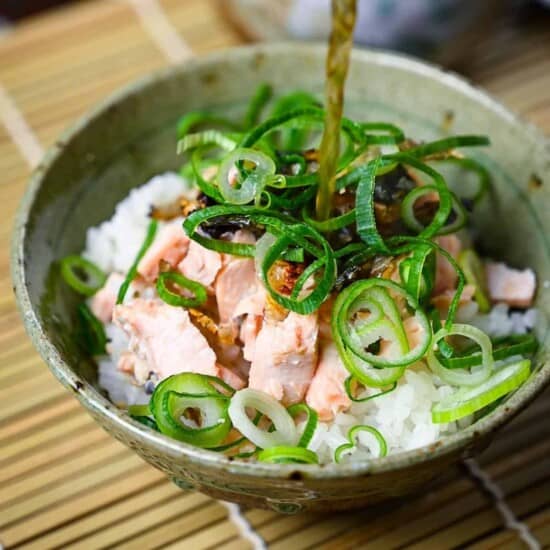




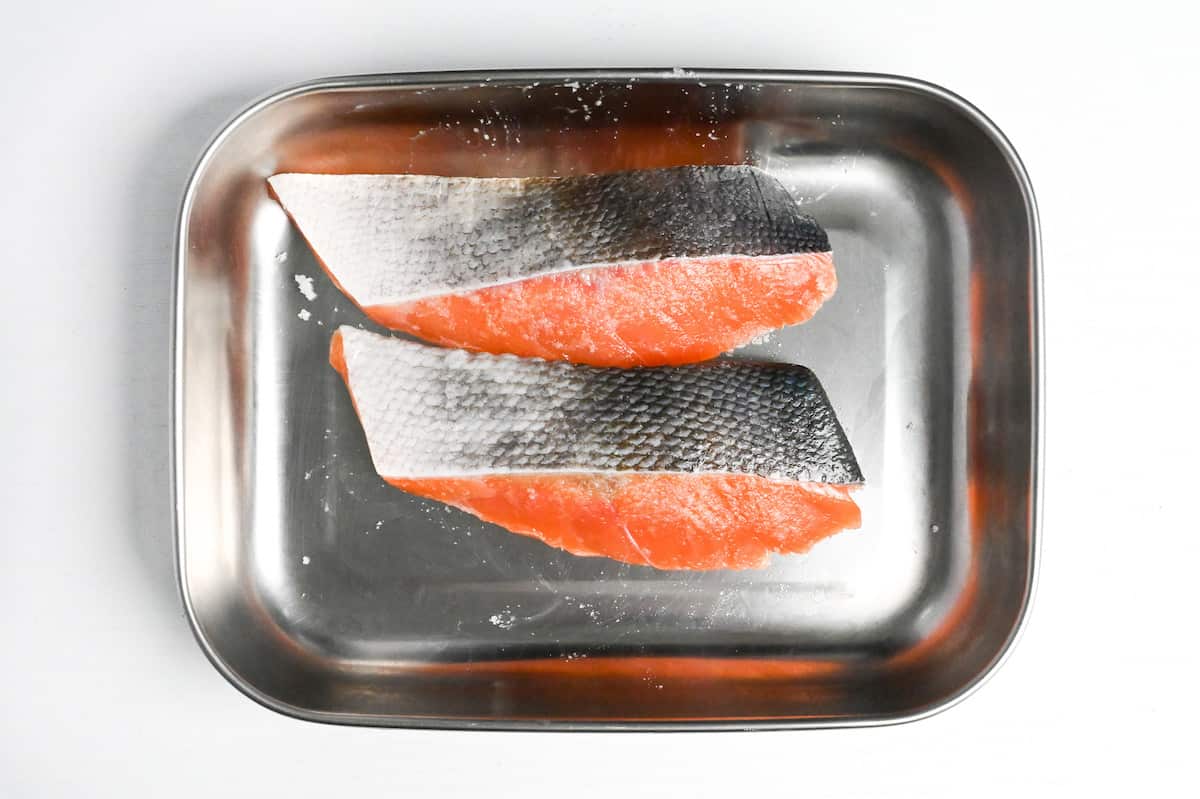
It was delicious and so easy to make. It tastes just like the delicious homemade ochazuke I had at a restaurant in Japan. Thank you!
Hi Tran,
Thank you for the lovely comment and sharing your experience! I’m glad to hear that you enjoyed the recipe! 🙂
Yuto
Growing up, my family had Ochazuke often as we ate rice with every meal, even if we made potatoes for roasts(rice and gravy delicious). Homemade pizza, we ate with rice; can you imagine my shock when I got older and went to my first pizzeria and ordered a side of rice and they looked at me with shock and told me no pizzeria served rice with pizza Haha. I just wanted to share that for lunch my Dear Beloved Japanese Dad loved having his Ochazuke with grilled hotdogs, I smile and softly giggle when I think about that; I miss him Dearly! Thank You reminding me of that Wonderful memory! Now I have to go make some rice and I have a beautiful piece of Halibut to cook. Thank You So Very Much Yuto Omurasan
Hi Canako,
Thank you for your comment! What a beautiful memory—thank you so much for sharing it with me. I’m honored this reminded you of your good memories. Wishing you a cozy lunch with that halibut and rice! 🙂
Yuto